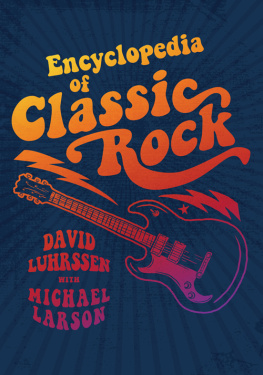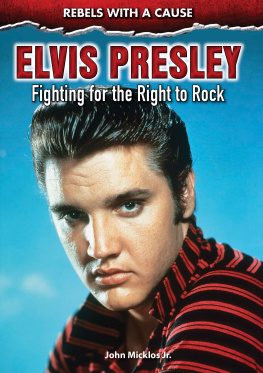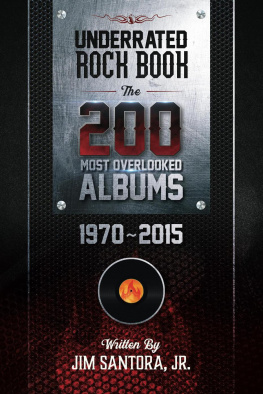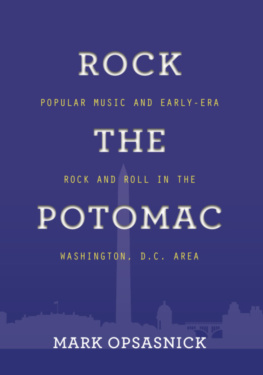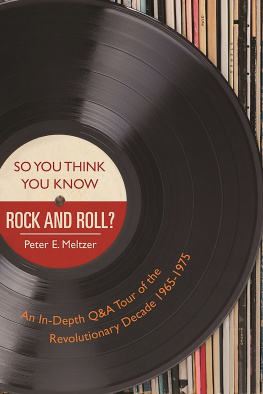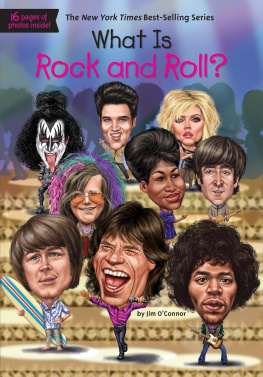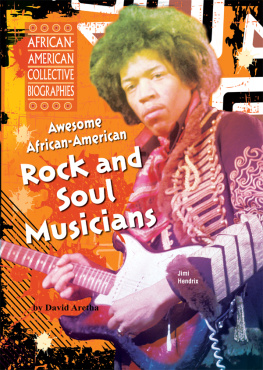Encyclopedia of
Classic Rock
Encyclopedia of
Classic Rock

DAVID LUHRSSEN WITH MICHAEL LARSON

Copyright 2017 by ABC-CLIO, LLC
All rights reserved. No part of this publication may be reproduced, stored in a retrieval system, or transmitted, in any form or by any means, electronic, mechanical, photocopying, recording, or otherwise, except for the inclusion of brief quotations in a review, without prior permission in writing from the publisher.
Library of Congress Cataloging-in-Publication Data
Names: Luhrssen, David. | Larson, Michael.
Title: Encyclopedia of classic rock / David Luhrssen with Michael Larson.
Description: Santa Barbara, California : Greenwood, [2017] | Includes bibliographical references and index.
Identifiers: LCCN 2016038277 (print) | LCCN 2016038768 (ebook) | ISBN 9781440835131 (alk. paper) | ISBN 9781440835148 (ebook)
Subjects: LCSH: Rock musicBio-bibliographyDictionaries.
Classification: LCC ML102.R6 L84 2017 (print) | LCC ML102.R6 (ebook) | DDC 781.66092/2 [B] dc23
LC record available at https://lccn.loc.gov/2016038277
ISBN: 978-1-4408-3513-1
EISBN: 978-1-4408-3514-8
21 20 19 18 17 1 2 3 4 5
This book is also available as an eBook.
Greenwood
An Imprint of ABC-CLIO, LLC
ABC-CLIO, LLC
130 Cremona Drive, P.O. Box 1911
Santa Barbara, California 93116-1911
www.abc-clio.com
This book is printed on acid-free paper 
Manufactured in the United States of America
Contents
Preface
The Encyclopedia of Classic Rock offers a historically grounded definition of new and aesthetically daring forms of rock music that became culturally dominant from 1965 through 1975 in the wake of the creative breakthroughs of the Beatles and Bob Dylan. With the example of those artists before the ears of the world, rock music coalesced as a self-conscious art form by 1965, stretching the boundary of popular music and elevating the long-playing album into a primary canvas for artistic expression. Many aspiring writers who in an earlier epoch might have penned short fiction or poetry turned instead to rock songs. Rock also absorbed much of the musical creativity directed in earlier times toward jazz and blues. By 1975 much of that energy had begun to dissipate.
The Encyclopedia of Classic Rock does not explore the sociology behind the music but takes for granted that the postWorld War II baby boom, the musics primary audience from 1965 through 1975, represented a historically large cohort of young people conscious of being distinct from previous generations, and with unprecedented affluence in ideas as well as consumer goods. Classic rocks depth of influence was made possible by the rise of middle-class youth in North America and Western Europe but spread across the globe.
The first book of this kind, Lillian Roxons Rock Encyclopedia (1969), was published as events were still unfolding and therefore lacked historical perspective. The Rolling Stone Encyclopedia of Rock & Roll (1983) included many artists who had nothing to do with rock, much less classic rock, and its compilers were sometimes misinformed on exact titles and release dates of albums and on biographical details. The All Music Guide to Rock: The Definitive Guide to Rock, Pop, and Soul (2002) encompassed all popular music from the rock era and, as the work of many hands, lacked a consistent perspective. The Encyclopedia of Classic Rock is the only encyclopedia with its particular focus and fills in gaps in the existing literature by stressing the musical and cultural importance of rock groups from outside the United States and United Kingdom, especially bands from West Germany in the 1970s. It reminds readers of the fact, often overlooked in recent accounts of the 1960s, that Dylans primary importance was not as a protest singer, a label he soon rejected, but for affirming the possibility of rock lyrics as the poetry for a new age and raising the prospect, alongside the Beatles, of rock as an art form that transcended its roots. In tone and manner, the encyclopedia is written to accommodate a broad audience ranging from secondary school students to scholars in postgraduate settings.
The introduction proposes a precise definition of classic rock in art history terms and aims to establish classic rock as a distinct artistic movement comparable to Dadaism or German Expressionism, modernist movements that flourished briefly in the 20th century and left behind a residue of enduring influence. The text entries are arranged alphabetically, permitting the reader to easily browse the roster of artists from the classic rock era. The authors have endeavored to balance the twofold goal of understanding the meaning of those artists in historical hindsight while at the same time remembering the often startling impression they made within the context of their time. Appended to each artist entry is a list of suggested albums chosen for aesthetic merit or historical importance and dated according to the year of their original release. Alphabetized along with artist entries are short essays on particular topics germane to the encyclopedias themes, including definitions of genres from blues to space rock, related topics including rock criticism and rock festivals, and entries focused on rock music in such unexpected locations as Eastern Europe, Cambodia, and Turkey. A Recommended Reading list at the end of the Encyclopedia of Classic Rock lists the works that most profoundly influenced our thinking about rock music and attempts to sift the wheat of meaningful rock scholarship and criticism from the mountains of chaff produced by pseudo-intellectuals, starstruck fans, and scandal-seeking gossipmongers. The Encyclopedia of Classic Rock examines the personal lives of its subjects only to the extent that the personal became public through their music.
Acknowledgments
The authors were fortunate to come of age during the final half of the period covered in this book in a city where the music from the classic rock era was easily accessible. Milwaukee had no less than two free-form FM rock stations in the early 1970s, WZMF and WQFM, as well as occasional underground rock programs on college station WUWM. The names of most of the DJs escape our memory, but one was outstanding for influencing the imagination of his listeners, Bob Reitman. We were also fortunate to have a local rock critic, Pierre Rene Noth, whose ideas and search for lesser-known artists provided weekly stimulation through his column in the citys evening paper, the Milwaukee Journal. Additionally, we were exposed to album releases and concert reviews in the local underground newspaper, the Bugle American, and a music publication, Fallout.
Many of our perceptions were formed from lively conversations with musicians and music buffs throughout our lives. We especially thank Glen Rehse for his insights into psychedelia, classical rock, and the German scene of the 1960s and 1970s; Martin Jack Rosenblum for his understanding of the roots of rock and the role of Bob Dylan in the 1960s; Mark Krueger for his knowledge about Van der Graaf Generator and continental European bands; and Jamie Lee Rake for African American music and his contributions to the entry on the band War. Our research benefited from the eager assistance of Bruce Cole at Marquette Universitys Raynor Memorial Library, Kevin Coxworth for lending us some rare recordings, and Mary Manion for her tireless searches on a medium whose future existence we never suspected while growing up, Amazon.
Next page
